
IMPORTANT NOTE: As this section is quite large now, I have divided it into two parts - this one and Part 2 on APCs from converted tank hulls and miscellaneous vehicles including those used during the War of Independence (okay, so this is not quite in chronological order, but anyhow).
I think something of a systematic approach is needed here. Therefore let's start with a short overview of the Halftrack family. The prototype of the Halftrack family was actually a the body of a M-3 Scout car on a modified half-tracked truck (M-2) chassis. Not without logic this vehicle was - when standardized - called M-2 Halftrack. Initially it was designed to be an artillery prime mover. Parallel to that, the slightly longer M-3 was developed, which offered increased seating capacity (13 instead of ten). Both variants were produced in large numbers by three suppliers: Autocar, White and Diamond T. As requirements for additional vehicles steadily rose, International Harvester Co. also started producing Halftracks. These were slightly modified versions, designated M-5 and M-9 respectively. Whereas the M-2/M-3 variants were mainly used by the Americans themselves, the Allies were mainly supplied with International Harvester Vehicles. All variants were also used as a basis for SPG-conversion; some of these conversions were eventually purpose-built. Among the most important range the M-16 SPAA, mounting four .50 cal MGs in a T-55 turret, based on the M-3 Halftrack, and the similar M-14 based on the M-5/M-9 vehicles. Many of the latter Halftracks in British use were during the latter phase of the war and thereafter converted to normal APCs (making confusion complete, methinks!!!).
As far as APCs are concerned the following picture emerges (the important M-16, M-14 and M-4 are included; I left the numerous other SPG variants out for the obvious reason - there are dozens of them!):

Important question. As I already stated above, the main difference between the M-2 and M-3 halftracks is the length of the rear compartment. I cobbled together the drawing below to illustrate this. On the left hand is a M-3, note the lengthened rear compartment. The M-2 on the right side has a shorter rear compartment as well as ammunition lockers on the side of the latter (also indicated by an arrow).
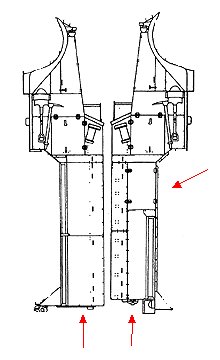
Another word on the drawing above: As you can see, I left any chassis and suspension detail out for clearity's sake. I should probably also have left out pioneer tools and other detail, but, well, it didn't seem worth the effort...
...
The IDF is known to be the biggest operator of the venerable Halftrack. It was already used in the War of Independence as an APC by certain mechanized units and was turned into a multipurpose vehicle afterwards - fitter vehicles, C&C-vehicles and the like.
During the latter stages of the War of Independence mobile columns relied heavily on the halftrack as an APC. Reference pictures show various types fitted with or without a pulpit and equipped with roller or winch as well as lacking either. The profile below depicts a vehicle used in the Negev against the Egyptians. It is equipped with a roller (B) and a pinthle-mounted MG 34 (A).
Note also the three white arrows, an identification sign very common on vehicles of that period. These were often also adorned with hebrew numbers and/or letters (sometimes also slogans and drawings), which I left out. Consult reference pictures for these. The colour should be something like olive drab (the longer I look at the profile, the more I get the impression I should have used a darker colour).
After the War of Independence the M 3 APCs were modified by mounting a .3 cal machine gun to the right of the driver. Apart from that, canvas tops of various kinds were fitted to some vehicles. Both modifications can be clearly seen in the pictures below.
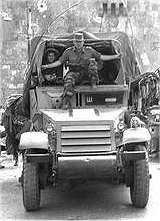 |
|||||
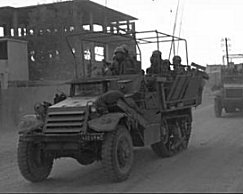 |
|||||
M 5 APC |
M 3 APC |
||||
Note in the picture on the left the flat-winged M 5 as opposed to the M 3 on the right. Noticeable also the fact that the .3 cal machine gun is not mounted.
In 1973 the halftrack was still the standard APC with the IDF. Note in the pictures below the extensive crew stowage on the vehicle on the right which again happens to be a M 5. Note the jerrycan holder which is slightly different than the original one.
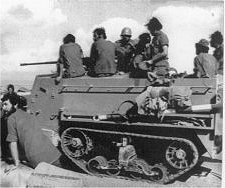 |
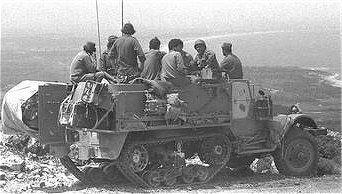 |
||||
M 3 (?) APC |
|||||
M 5 APC |
|||||
For the manyfold conversions based on the halftrack cf. the SPG section. Apart from the vehicles listed there, halftracks were and still are used in a substantial number of support roles, i.e. as fitter vehicles, radio/communication vehicles, chemical warfare vehicles and the like.
...
As far as I see at the moment there are two kits readily available on the market now.
This kit, one of the few Airfix kits that really are closer to 1/72 than to 1/76, comes with a pulpit, a trailer and some weird-looking figures. There is, however, no interior of the troop compartment that is worthy the description... Overall fit is good, quality of the parts is acceptable, some of the finer detail being actually quite nice, although I am not happy with having the tools moulded on. The wheels are also of rather questionable quality. What I consider to be the main advantage of this kit is the one-piece suspension-track section which is far better than any solution using vinyl tracks. The suspension unit has adequate detail and the moulding seam running parallel with the tracks is barely visible when installed.
But - you might have guessed it - there is one main drawback to this kit: it has the flat-section wings of the M-5/M-9 series but the angular troop compartment of the M-3. Whoops. Thus you have to build either new wings or correct the troop compartment to build a correct represenation of any type of Halftrack. Nonetheless, this doesn't pose any maior problems. If you are not into super-detailing, it may just be sufficient to sand the edges of the troop compartment round. Therefore I would on the whole recommend it - it's readily availible, it's cheap and you can make quite a lot out of it. Oh, and you get a trailer with it.
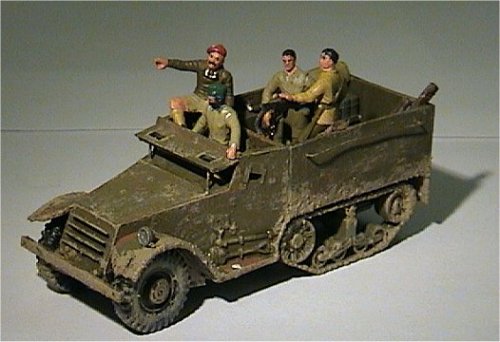
The picture above shows a battered M 3 in 1948. It was built up from a rather pitiful wreck lacking wheels and all other small parts; the front wheels which came from the spares box are far from optimal. Crew is my usual mixture of Matchbox, Preiser and Esci parts.
Hasegawa's Halftrack, which comes as mortar carrier as well as M3A1, is dimensionally quite close to 1/72, for a change. Although having more interior detail in the troop compartment and being a fairly correct representation of an M-3 based SP Mortar (I almost forgot: again some funny figures included), I consider this kit to be inferior in comparison to the Airfix offering. The vinyl tracks are horrible, to say the least, there is something wrong with the suspension units and detail tends to be on the heavy side. The mortar is fairly crude, the mortar provided with Revell's US Infantry (winter cloths) set being far better, although it's from soft plastic.
In all, as I said, rather inferior to the Airfix offering, more expensive and harder to get where I live - and, hey, no trailer provided!
This was the best Halftrack kit on the market, unfortunately it's gone now. It featured very nice overall detail accurate in 1/76 (making it noticeably smaller than the Airfix one!), the only drawback being the vinyl tracks, which are difficult to work with. As it's a M 16 SPAA (actually probably a M-16A1 with moveable side panels but without armoured shields), you have to rebuild the troop compartment for an APC, but that should be rather easy; after all, it's only a box-shaped structure (and no rounded rear corners...)! As a bonus you get a perfect M-55 turret, which can be put to excellent use either as a towed weapon or installed for example in a BTR-152, cf. the Artillery and Captured Vehicles section.
Footnote: Revell apparently rereleased this kit in a set with the US Infantry set mentioned above. Yippeh!
Another footnote: According to their newest catalogue, Revell has discontinued this set. Boo-hooo!
I won't go into great detail on the development of the M 113 APC, as it could only be inferior to R. P. Hunnicutt's masterly reference work. So for technical details and development history refer to his "History of the American Infantry Fighting vehicle".
However, one main characteristic needs to be pointed out: Although the M 113 and variants of it like the M 114 or the YPR-765 are still in use with many armies nowadays, some of the latter using them indeed in a kind of infantry fighting vehicle (IFV) role, the M 113 is in reality nothing more than a battle taxi and NOT an IFV. If you find a representative of FMC telling you something different, smack him! It was developed according to an US army requirement for an airportable fully tracked vehicle meant to transport infantrymen to the battlefield. As it had to be both airportable and amphibious it was largely made of aluminium, providing protection against small arms and HMG rounds. As the infantry was not meant to fight from the vehicle, no slots or the like were provided. For the use as a mere transport vehicle, protection was adequate, but only for that use, as will shortly be seen...
By the way, there are basically two APC versions (I'm oversimplifying, but there's no need to make matters too complicated): the petrol engined M 113 and the diesel engined M 113A1.
The very first M 113s to come into Israeli hands were captured from Jordanian forces during the Six Day War. I have yet to find a reference picture for one of these vehicles, so for now I have no further information on equipment and colour scheme. In the early 1970s Israel started to buy M 113s on a large scale in order to replace the halftracks in mobile units (although this was not achieved until the late 1980s). The picture below shows an unmodified M 113. Note extensive crew stowage and additional protection for the machine gunners provided by sandbags.
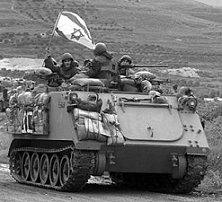 |
The picture on the left shows an unmodified M 113. Note the extensive external crew stowage. Additional protection for the machine gunners is provided by sandbags. Although the picture actually portraits a vehicle during the 1982 operations, unmodified M 113s are still in use with the IDF. | |||
unmodified M 113 |
||||
During the Yom Kippur War they were used for the first time in combat. On the one hand they proved to be useful and extremely versatile, on the other hand their thin aluminium armour made them rather vulnerable in a hostile environment. The action at Buq'atta during the Yom Kippur War is a particular case in point, when most of 7th Recon Co was litteraly wiped out when trying to assault Syrian positions with their M 113s. Indeed, open-topped M 3 halftracks might have given their crews better chances to bail out after a hit than the M 113 with the petrol tank inside the troop compartment...
This led to the development of armour upgrade kits in order to provide better protection against RPG rounds and the like. In the picture below you can see two different types of armour upgrade. The left picture shows a rather concentional add-on armour suite, mainly designed to detonate shaped-charge warheads prematurely. On the right, a more radical solution can be seen, involving reactive armour cells. This is a far cry from the original design. Note also the polygonal machine gun turret on the vehicle on the right.
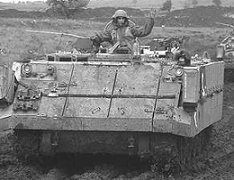 |
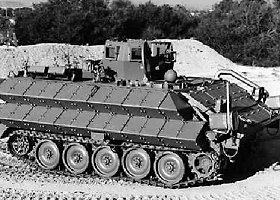 |
||||
M113 with add-on armour |
|||||
M113 with reactive armour suit |
|||||
Even with these upgrades, however, the M 113 was and is still not suited to accompanying MBTs on the battlefield, its survivability being marginal. I have talked to several ex-servicemen, who all agreed that even with an armour upgrade a M 113 is definitely not the place you want to be in when the air is full of SABOT rounds...
Thus new solutions were sought for the problem of providing an APC, which is capable of surviving in a hostile environment and can double as an IFV when needed without putting its crew into mortal danger. Eventually, a solution was found in the form of an concept dating from WWII. More of that in Part 2.
Modelling the M 113 is thankfully very easy, as JB Models has a kit on offer and Italeri will re-release Esci's M 113A1 this year. Based on those two all of the different versions in use by the IDF can be built.
JB-Models has two interesting variants of the M 113 in their range, an ACAV vehicle and Australian fire support version mounting a Saladin turret (I read somewhere that these had a tendency to capsize when the main gun was used while afloat...). If you have visited this site before, you might have noticed I was once quite happy with it. After an intensive M 113-building program this has changed somewhat. I'll briefly highlight some important points.
1. Suspension - One interesting feature of these kits is a single piece wheels/tracks assembly. Personally I find this very comfortable as it eases construction considerably, at the expense, however, of some detail, most noticeable on the tracks. In case you are into wargaming, however, it guarantees speedy construction.
2. General level of detail - 'Fair' would actually be a compliment. Although everything is there, headlights, spare tracks, tools etc. are molded directly onto the hull and don't even remotely resemble the original thing. The only cure is to shave everything off the hull and replace it with scratchbuilt items (which, of course, slows down construction considerably...). The 12.7mm mg is barely acceptable, the 7.92mm mgs look rather like some Star Trel weaponry, so into the bin with them! The figure provided has a nice head with good facial detail, but everything below his shoulders is rather poor. If you need some crew, take the head and mate it to a different figure. On driver's hatch and commander's cupola see below.
3. Scale Accuracy - A tricky question. The kit is NOT accurately to 1/76; actually, whereas suspension and hull length are close to 1/72, hull width is between 1/76 and 1/72; driver's hatch and commander's cupola are very close to 1/76, so it's all quite a mess, scale-wise.
Overall assessment on the basic kit? Well, the hull is inaccurate, and it shows to anybody who knows a bit about M 113s - it's simply too narrow (or too high and too long, if you want). However, if you put Toga add-on armour around it, nobody will notice. It's different especially with the cupola. Actually, the Esci one (see below on the kit) looks good on the kit (but then you could go for the Esci kit in the first place). Personally I think the JB Models kit lends itself to various conversions which replace the cupola with anything else.
What about the additional parts on the two different versions? The ACAV version parts are particulary useful as they can be used to model a very interesting version of the M 3 Halftrack (cf. here). You might consider, however, to replace the gun shields with plastic sheet closer to scale thickness (although the commander surely feels veeeeery safe behind his battleship-issue armour plate...).
By the way, the Australian FSV can be easily modified into an upgraded version of the same vehicle by replacing the Saladin turret with a Scorpion turret from the Airfix kit.
Esci once had a quite a number of M113-based vehicles in their range, which hopefully will one day be rereleased by Italeri. As far as I am aware of these were the basic M113A1, a M113A1 ACAV, the M 163 Vulcan SPAA, the M 901 TOW SPATGM and the M 125 81mm mortar carrier. Today, only the basic M113A1 is in the process of being rereleased, so my notes below only relate to this kit; however, as it is the basis for all other kits, they will be useful for building the other ones as well.
1. Suspension - The kit features very nice link-and-length tracks and overall good suspension detail. Sometimes it was criticized that the roadwheels are single pieces, whereas they really should be two-part units, a problem common with Esci kits. However, on the finished kit you can't really see this with the mudguards mounted, so I can perfectly live with that (hey, I can live with the JB models suspension!).
2. General level of detail - Very inconsistent, if I may say so. Some part are really nice, like the 12.7mm machine gun, some of the tools etc. Moreover, a basic interior is provided that is quite accurate and serves as a sound basis for a superdetailing project. However, other parts I find not too convincing. The trim vane looks more like a piece of frontal armour for a MBT (I actually cut one up into pieces, using them as reactive armour panels...), making a scratchbuilt replacement necessary
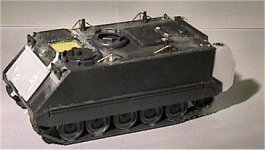
Okay, that may not be the best of photographs, but you can just make out some of the necessary modifications - trim vane, roof hatch, antenna guards (the one with the wrong shape has been replaced since the picture has been taken) etc.
Likewise the main roof hatch also rather looks like some bunker door and is quite dissimilar to the original piece made out of rather thin aluminium. There are no antenna mount guards provided - on the other hand, if they were, I would probably say they're too thick, so it's just as well, just take some wire and scratchbuild them. The detail moulded onto the hull is also not too crisp - the periscopes therefore could well be further detailed, the front hull hatch also will profit from further detailing.
3. Scale accuracy - In my humble opinion the Esci kit is very accurate to 1/72. Likewise, overall shapes are good, it looks every inch a M 113.
Overall assessment on the basic kit? Well, I like it. It's not as easy to build as the JB Models one, but it looks very much like a M 113. If you need a larger number of models, the JB Models offering is the obvious choice (especially when you cover it with add-on armour). However, if you want to model one of the basic M 113 variants and put some work into detailing it, get the Esci/Italeri kit. Below are a few notes on another M 113 model, which is very inferior to the kits just discussed; it's included for completeness only.
In contrast to their recent releases which are of high quality - although at exorbitant prices... - this kit is probably their least successful effort. It is quite out of shape being too short and too wide in a way instantly noticeable. Detail is fair and not very crisp, the whole affair looks more like a short-run kit. It seems that this kit has now been dropped from their range.
For Part 2 look here!